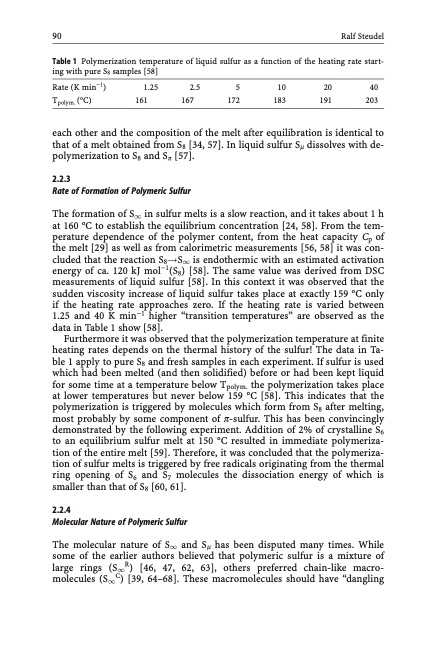
PDF Publication Title:
Text from PDF Page: 100
90 Ralf Steudel Table 1 Polymerization temperature of liquid sulfur as a function of the heating rate start- ing with pure S8 samples [58] Rate (K min1) 1.25 2.5 5 10 20 40 Tpolym. (C) 161 167 172 183 191 203 each other and the composition of the melt after equilibration is identical to that of a melt obtained from S8 [34, 57]. In liquid sulfur Sm dissolves with de- polymerization to S8 and Sp [57]. 2.2.3 Rate of Formation of Polymeric Sulfur The formation of S1 in sulfur melts is a slow reaction, and it takes about 1 h at 160 C to establish the equilibrium concentration [24, 58]. From the tem- perature dependence of the polymer content, from the heat capacity Cp of the melt [29] as well as from calorimetric measurements [56, 58] it was con- cluded that the reaction S8!S1 is endothermic with an estimated activation energy of ca. 120 kJ mol1(S8) [58]. The same value was derived from DSC measurements of liquid sulfur [58]. In this context it was observed that the sudden viscosity increase of liquid sulfur takes place at exactly 159 C only if the heating rate approaches zero. If the heating rate is varied between 1.25 and 40 K min1 higher “transition temperatures” are observed as the data in Table 1 show [58]. Furthermore it was observed that the polymerization temperature at finite heating rates depends on the thermal history of the sulfur! The data in Ta- ble 1 apply to pure S8 and fresh samples in each experiment. If sulfur is used which had been melted (and then solidified) before or had been kept liquid for some time at a temperature below Tpolym. the polymerization takes place at lower temperatures but never below 159 C [58]. This indicates that the polymerization is triggered by molecules which form from S8 after melting, most probably by some component of p-sulfur. This has been convincingly demonstrated by the following experiment. Addition of 2% of crystalline S6 to an equilibrium sulfur melt at 150 C resulted in immediate polymeriza- tion of the entire melt [59]. Therefore, it was concluded that the polymeriza- tion of sulfur melts is triggered by free radicals originating from the thermal ring opening of S6 and S7 molecules the dissociation energy of which is smaller than that of S8 [60, 61]. 2.2.4 Molecular Nature of Polymeric Sulfur The molecular nature of S1 and Sm has been disputed many times. While some of the earlier authors believed that polymeric sulfur is a mixture of large rings (S1R) [46, 47, 62, 63], others preferred chain-like macro- molecules (S1C) [39, 64–68]. These macromolecules should have “danglingPDF Image | Topics in Current Chemistry

PDF Search Title:
Topics in Current ChemistryOriginal File Name Searched:
Elemental-Sulfur-und-Sulfur-Rich-Compounds-I.pdfDIY PDF Search: Google It | Yahoo | Bing
Sulfur Deposition on Carbon Nanofibers using Supercritical CO2 Sulfur Deposition on Carbon Nanofibers using Supercritical CO2. Gamma sulfur also known as mother of pearl sulfur and nacreous sulfur... More Info
CO2 Organic Rankine Cycle Experimenter Platform The supercritical CO2 phase change system is both a heat pump and organic rankine cycle which can be used for those purposes and as a supercritical extractor for advanced subcritical and supercritical extraction technology. Uses include producing nanoparticles, precious metal CO2 extraction, lithium battery recycling, and other applications... More Info
| CONTACT TEL: 608-238-6001 Email: greg@infinityturbine.com | RSS | AMP |